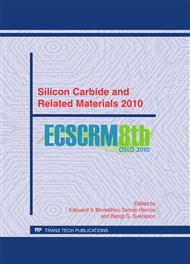p.797
p.801
p.804
p.808
p.812
p.816
p.820
p.824
p.831
Single-Crystal Silicon Carbide: A Biocompatible and Hemocompatible Semiconductor for Advanced Biomedical Applications
Abstract:
Crystalline silicon carbide (SiC) and silicon (Si) biocompatibility was evaluated in vitro by directly culturing three skin and connective tissue cell lines, two immortalized neural cell lines, and platelet-rich plasma (PRP) on these semiconducting substrates. The in vivo biocompatibility was then evaluated via implantation of 3C-SiC and Si shanks into a C57/BL6 wild type mouse. The in vivo results, while preliminary, were outstanding with Si being almost completely enveloped with activated microglia and astrocytes, indicating a severe immune system response, while the 3C-SiC film was virtually untouched. The in vitro experiments were performed specifically for the three adopted SiC polytypes, namely 3C-, 4H- and 6H-SiC, and the results were compared to those obtained for Si crystals. Cell proliferation and adhesion quality were studied using MTT [3-(4,5-dimethylthiazol-2-yl)-2,5-diphenyltetrazolium bromide] assays and fluorescent microscopy. The neural cells were studied via atomic force microscopy (AFM) which was used to quantify filopodia and lamellipodia extensions on the surface of the tested materials. Fluorescent microscopy was used to assess platelet adhesion to the semiconductor surfaces where significantly lower values of platelet adhesion to 3C-SiC was observed compared to Si. The reported results show good indicators that SiC is indeed a more biocompatible substrate than Si. While there were some differences among the degree of biocompatibility of the various SiC polytypes tested, SiC appears to be a highly biocompatible material in vitro that is also somewhat hemocompatible. This extremely intriguing result appears to put SiC into a unique class of materials that is both bio- and hemo-compatible and is, to the best of our knowledge, the only semiconductor with this property.
Info:
Periodical:
Pages:
824-830
Citation:
Online since:
March 2011
Price:
Сopyright:
© 2011 Trans Tech Publications Ltd. All Rights Reserved
Share:
Citation:


